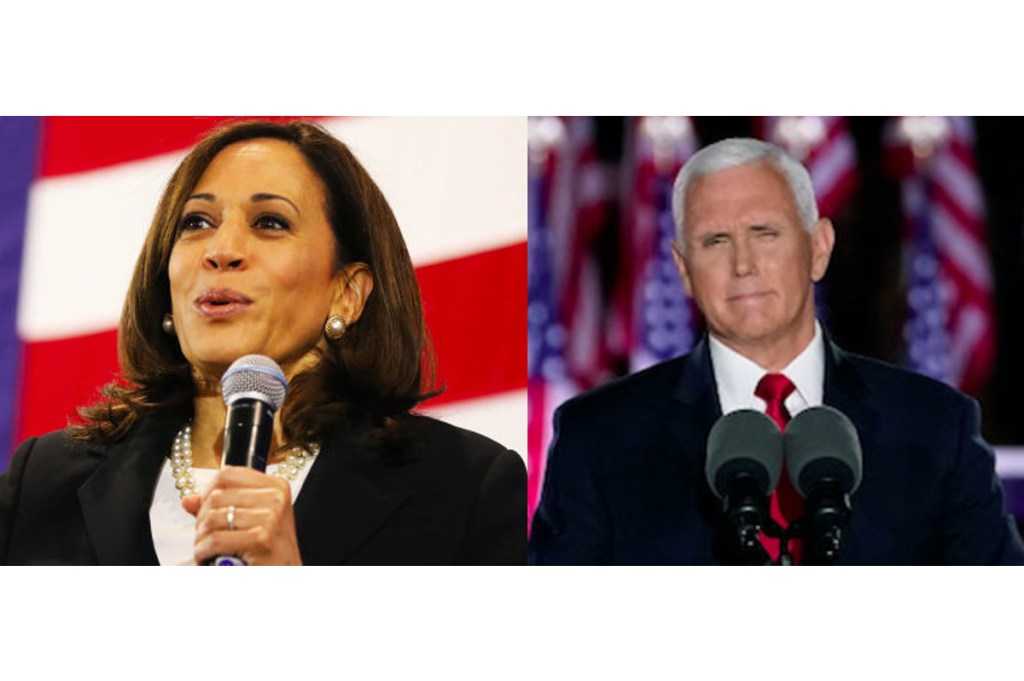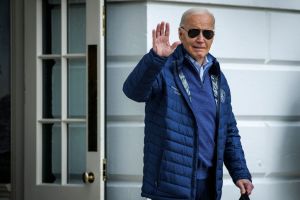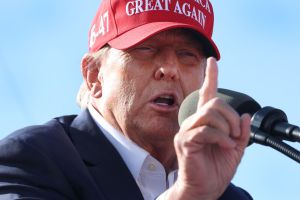What’s the bottom line so far?
The Democrats think they will win by making the race a referendum on Donald Trump (more the person than the policies, though they hate both). They are effectively trying to run Joe Biden as a generic Democrat.
The Republicans think the path to victory is to make the race a choice, Trump versus Biden, to say the Democratic party is dominated by the far left and that Biden is unable or unwilling to stop that oppressive movement. Drawing a sharp contrast between the two parties was the whole point of Vice President Mike Pence’s speech to conclude the convention’s third night. For the most part, though, Republicans focused on the positive case for Trump, not the negative one for Biden. They featured lots of everyday Americans who said they had been helped by Trump’s policies, sometimes adding that he had reached out to them personally.
The Democrats made a very strong negative case, devoting almost their entire convention to attacks on Trump, leavened by their depiction of Joe Biden as a genuinely decent guy. Their policies got very little attention.
The parties did agree on one thing: the differences between them are stark. Both make a convincing case that this is the most consequential election in decades.
How did the two conventions differ?
The Republicans featured many more live events, lots more everyday people, and considerably more attention to their policies, particularly those that matter for swing states in the upper Midwest. They used personal stories both to humanize the President and to show how his policies have helped this farmer, that lobster fisherman, this small businessman, and that former criminal. They took full advantage of incumbency, using the White House for a naturalization ceremony, a presidential pardon, and the First Lady’s speech. Using Fort McHenry as the backdrop for Pence’s speech was extremely effective, as was the decision to include a good-sized audience. The tone of the entire convention was upbeat, inclusive, and patriotic.
The Democratic convention said little about their proposed policies but a lot about Trump’s and the damage they were inflicting on the country. Leveling that criticism for four days makes for a gloomy production, despite the Hollywood stars and slick production values. The convention spokesman was the Hon. Debbie Downer.
The ray of sunshine was the future Biden would bring, but they said very little about the specific policies and how they would differ from Trump’s. The details were up to you. Biden himself was expected to offer that substance in his closing address, but he opted not to. Why? Because Democrats are a deeply divided party, held together mainly by their shared loathing of Donald Trump. As Alexandria Ocasio-Cortez said several months ago, in other Western countries, she wouldn’t be in the same party as Biden, Pelosi, Hillary and other mainstream Democrats.
Party leaders understand that cleavage, and they know what makes it worse: specific policy proposals. The more they discuss how much they will raise taxes or how fast they will move the economy to green energy, the more they drive a wedge between the two wings of the party. Indeed, Biden was so cautious that he never condemned the surge of urban violence, some of it happening while the convention was held. This silence and vagueness had a clear political goal: don’t offend the party’s leftwing as you appeal to undecided centrist voters. The only way to do that is to avoid any details and trust the friendly media not to ask.
What do the conventions have in common?
Both were aimed primarily at mobilizing base voters. Like all conventions, they are much more about revving up enthusiasm among the party faithful than about convincing independents.
The Republicans made two significant detours from that conventional strategy. One was their concerted effort to speak to African Americans, few of whom voted for Trump in 2016. That focus is designed not only to increase those vote totals, which could tilt the balance in swing states, but also to reassure all voters that Trump is not a bigot. The other detour was to feature working-class speakers from swing states like Minnesota, who could speak about the Iron Range or logging.
The conventions signal a long-term realignment of American voters
Those working-class speakers underscore a tectonic change in American voters’ party alignment. Blue-collar workers, the heart of the Democratic party since the Great Depression, increasingly identify as Republicans. By contrast, prosperous, educated suburbanites, who were once liberal Republicans, are now mostly centrist Democrats. There are very few ‘Rockefeller Republicans’ or ‘Blue Dog Democrats’ still walking the earth, seeking votes.
Mobilizing their base means different things to the two parties
When the Democrats told viewers to get out and vote, they were doing something more than saying what every party does. They were also trying to hold their activist base together, less by what they said and more by what they didn’t say. They avoided mentioning many of the country’s biggest issues because those are so divisive within the party. The Biden-Harris ticket could either explain what they want to do, if elected, or they could ignore those issue to maintain party unity. Not surprisingly, they chose unity.
The Democrats’ problem is that they have two bases, not one. Their activist base is very far left, but party also needs lots of traditional center-left Democrats, both as voters and donors. It is impossible to discuss hot-button issues like urban rioting and defunding the police without alienating one group of the other. So, the Democratic convention skipped it, and Biden himself has avoided interviews where he might be forced to commit himself. For him, the ideal interviewer would Teen Vogue.
The Republican party also has its factions, but today’s party is dominated by Trump’s personality, his populism, and his policies. It is the Party of Trump. Yes, there are traditional conservatives of the Mitch McConnell stripe with close ties to big business. There are some more traditional, center-right officials, like Sen. Susan Collins of Maine and Gov. Larry Hogan of Maryland. But, like all modern parties led by an incumbent president, they reflect his views and his winning coalition. In Trump’s case, that coalition is populist and nationalist. What they have in common with traditional conservatives is their open expression of patriotism and religion and their desire to cut taxes and regulations, build a strong military, restrict abortions, and limit the growth of centralized government. The Republican convention naturally stressed those common issues.
Why have the Republicans featured so many African American speakers?
Two reasons, one of them obvious, one not. The obvious reason is that Donald Trump believes he can capture significantly more than the eight percent vote he got in 2016. Even a small increase could help him carry swing states like Pennsylvania, Michigan, Georgia, Florida and North Carolina.
The second reason is equally important but typically overlooked. Many white voters will not support a candidate they consider racist. Pause for a moment and reflect on how praiseworthy that is. Those are America’s best values, and they are widely shared. Voters want evidence their president treats everyone fairly, regardless of skin color, that he cares about our country’s racial divide and is doing something about it, not just appealing cynically for votes.
The Democrats have consistently labeled Trump — indeed, all Republicans — as anti-black. Trump and his party know they must counter that image, and they are trying to do so in several ways. First, they stress the positive impact of Trump’s policies, especially tax cuts and prison reform. His economic policies, they say, led to record employment numbers for Blacks, Hispanics and women before the pandemic struck. They will lead back to a robust economy for everyone, they said. Their point about criminal justice reform is not only that it freed many Blacks from prison, but it reversed the ‘Democrats’ failed policy’. Second, by featuring African Americans who support Trump as prominent speakers, they are saying to those voters, ‘You are not alone if you vote for Trump. Lots of us think the same way.’ That is why the speeches by Sen. Tim Scott and Kentucky Attorney General Daniel Cameron, a rising young star, were so important.
Third, they want to show Trump, as a person and not just as a politician, is no racist. That was the essence of Herschel Walker’s personal story about their 37 years of friendship, their dinners and conversations together. That was why the presidential pardon for Jon Ponder and Ponder’s moving story about his prison-to-work charity was so important. They did more than highlight the policy; they showed Donald Trump really cared about the people it helped. The video clips of Trump handing diplomas to each graduate of Ponder’s program and clearly enjoying it did just that. So did his moment with Ponder as he told him about the pardon. They drove the same point home on the third night with a talk by Clarence Henderson, who helped desegregate a Greensboro, North Carolina, lunch counter almost 60 years ago. His taped speech was especially powerful because he stood in front of a mural, honoring those who led the sit-in. Again, the message is directed at both black and white voters.
Both parties say ‘we think America is great; our opponents don’t’
Each says the sun won’t come up if the other side wins. That’s nothing new. Every convention says that. Every convention says this election is the most important of our lifetime and that the choice is stark. That’s truer sometimes than others. The starker the policy differences, the more convincing that theme is. It was more convincing, for instance, when Ronald Reagan ran against Jimmy Carter than when Gerald Ford ran against Carter. It is clearly true this year because the parties are so far apart on issues, probably further apart than in 2016. That’s less because Donald Trump has moved right than because the Democratic party has moved sharply left.
Still, the Republican convention is much more upbeat than the Democratic one. That’s predictable. The incumbent party always says ‘we are making things better’. That’s why they didn’t spend too much time talking about the pandemic.
What is different this year — and disturbing — is that both parties are painting the other as not just a bad choice but a truly evil one, perhaps even the end of America as we know it. Nancy Pelosi captured that venom this week when she called the Republicans domestic ‘enemies’. The Republicans capture it by depicting their opponents as full-fledged socialists.
Why did the Democratic convention say so little about the policies they want?
Because the more details they give, the more they risk splitting their coalition, composed of left-liberals and those much further left. Although the party platform is the most progressive of any major party in American history, it was still too moderate for activists who supported Bernie Sanders and Elizabeth Warren. Some 1,000 voted ‘no’ on the platform despite its significant promises to change energy policy, taxes, immigration, US foreign policy and more. Keeping that coalition together is why the Democrats stayed completely silent on urban violence.
[special_offer]
What have the Republicans stayed silent about?
Immigration. And they didn’t say much about the coronavirus.
Building a wall and stopping illegal immigration was the heart of Trump 2016 campaign. Yet the 2020 convention hardly mentioned it, despite Trump’s success in limiting illegal border crossings and building some 300 miles of wall. Why so silent? Probably because Trump thinks he can win a large Hispanic vote this time and doesn’t want to raise a divisive issue. Hispanics were helped enormously by Trump’s economic policies and are relatively conservative on social issues. They have been virtually mute during the Black Lives Matter protests. So, Trump’s campaign must be thinking they are ripe for his message of economic growth and law-and-order.


















